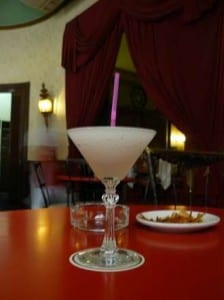National Daiquiri Day is July 19, one week from tomorrow. I usually remember the date because it happens to be my wife’s birthday (or perhaps I remember her birthday because…).
Like many of the classics, the origins of the daiquiri are mysterious. We do know that Daiquiri is the name of a beach located near the Bacardi home town of Santiago de Cuba. The most-repeated story is that the cocktail was invented by Jennings Cox, an American mining engineer working in Cuba during the Spanish-American War of 1898. However, it’s curious to note that the daiquiri also bears a close resemblance to a drink served to sailors in the British Imperial Navy from the mid-19th century onward, which consisted of rum, water, sugar, and lemon or lime juice (a friend of Jennings Cox, who was present when the drink was created, confirms that this was the origin of the daiquiri).
The daiquiri is one of the world’s great cocktails, despite certain atrocities regularly committed by people who own blenders. In its purest form, it is essentially a rum sour. The basic recipe calls for 1.5 ounces of light rum, ¾ ounce lime juice and ¼ ounce simple syrup. Although originally served in a highball glass with cracked ice, the version that became most famous was combined with crushed ice and vigorously shaken—the Floridita Daiquiri.
El Floridita was a bar that opened in Havana in 1817. Nearly a century later, a young bartender named Constantino Ribalaigua Vert turned up. Vert trained an entire generation of Cuban bartenders and eventually became the owner of the Floridita, but his real contribution was refining the daiquiri. His version contained maraschino liqueur and a splash of grapefruit juice, shaken until frosted. The arrival of Ernest Hemingway catapulted the daiquiri into hyperspace. The Floridita became Papa’s favorite hangout during his years in Havana, and he developed his personal variation on the Vert daiquiri (served in an outsized glass, with double rum and no sugar).
We, of course, are living through the last days of civilization. As if the blender wasn’t bad enough, many bars now proudly display the ultimate aberration—the frozen drink machine (they’ve even found their way into Sloppy Joe’s in Key West). This breakthrough reduces the daiquiri to the status of an alcoholic Slurpee, and has transformed the art of bartending into a process similar to serving frozen yoghurt.
While Bacardi may be closely associated with the history of the Daiquiri, there are other interesting choices when it comes to rum. Give Brugal a try—founded in 1888, it’s a family owned distillery located in the Dominican Republic. Brugal is currently the most popular rum in the Caribbean and #3 in sales worldwide. The rum is aged in white oak casks before being filtered and bottled, and production is closely monitored by the fifth generation of the family’s master distillers.
In terms of price, Brugal is comparable to Bacardi, with the Blanco Especial selling for $18 and the Anejo retailing at $25. Anejo (a blend of rums aged between three and five years) makes an excellent Daiquiri, with the rich, buttery texture of the spirit adding another dimension to the drink. There’s also an Extra Viejo ($30), consisting of rums aged for 5-8 years, but its nuances and complexity almost mandate that it be served neat in a snifter.
For many people, a large part of the appeal of a frozen strawberry or banana daiquiri is that you can’t taste the rum. Depending on your tolerance for spirits, this can be either a negative or a plus (these drinks are also fattening, but after several of them you won’t care much about that). One way around the extra calories and aesthetic displeasure of frozen daiquiris is to make your cocktail with flavored rum. Bacardi makes ten of them, including lemon, orange, raspberry, coconut and peach. Cruzan produces ten as well, and their spirits are both solid in quality and reasonable in price.
Enjoy National Daiquiri Day, and practice safe consumption—don’t drive, and make sure you securely fasten the top of the blender before you turn it on.
THE HEMINGWAY DAIQUIRI
(This recipe is an amalgam of many different versions. It contains twice the normal amount of rum, and was referred to at the Floridita as a Papa Doble. He drank it without the sugar, which would not be tolerable for most people)
3 ounces light rum
¾ oz. fresh lime juice
¾ ounce simple syrup
½ oz. maraschino liqueur
½ oz. grapefruit juice
Combine ingredients in a cocktail shaker with crushed ice; shake vigorously until frosted, and pour into a chilled cocktail glass.
ABOUT THE BOOK: Iconic Spirits: An Intoxicating History, by Mark Spivak, will be published in November by Lyons Press (hardcover, $16.95). Writing in an engaging and appealing style, Spivak chronicles the untold stories of one dozen spirits that changed the world and forged the cocktail culture. While some are categories and others are specific brands, “they are the best types of stories—the kind a writer could never make up.”
PRE-ORDER ON AMAZON:
http://www.amazon.com/Iconic-
Care to chime in? Follow this link and leave a comment:
http://www.iconicspirits.net/
Mark Spivak is an award-winning writer specializing in wine, spirits, food, restaurants and culinary travel. He was the wine writer for the Palm Beach Post from 1994-1999, and since 2001 has been the Wine and Spirits Editor for the Palm Beach Media Group, as well as the restaurant critic for Palm Beach Illustrated. His work has appeared in National Geographic Traveler, Robb Report, Ritz-Carlton, Continental, Art & Antiques, Newsmax, Dream of Italy and Arizona Highways. From 1999-2011 he hosted Uncorked! Radio, a highly successful wine talk show on the Palm Beach affiliate of National Public Radio.
Mark began writing Iconic Spirits after becoming fascinated with the untold stories behind the world’s greatest liquors. As a writer, he’s always searching for the unknown details that make his subject compelling and unique.
You can learn more about Mark at http://www.iconicspirits.net/index.htm
Maralyn D. Hill, The Epicurean Explorer
President, International Food Wine & Travel Writers Association
Blogs: Where and What in the World & Success with Writing
https://authorcentral.amazon.
Follow me: @maralynhill
FB: http://www.facebook.com/The.Epicurean.Explorer,, http://www.facebook.com/WhereandWhat.intheWorld, http://www.facebook.com/Success.With.Writing
Linkedin: http://www.linkedin.com/in/maralynhill















